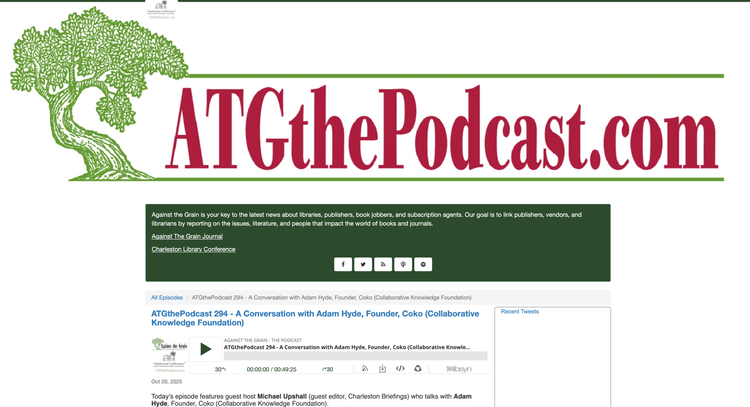Beyond the Cathedral: How Preprints and PRC Can Transform Academic Publishing

Publishing, for many academics, is an emblem of prestige, a mark of validation within their fields. It carries with it numerous signifiers of credibility—peer review, the venue of publication, citation counts, and other metrics. These elements combine to elevate publishing as a highly regarded activity, with journals historically serving as a hierarchical, carefully structured, and rigorously controlled approach to knowledge dissemination.
The emergence of preprint servers and new models like Publish-Review-Curate (PRC) is beginning to disrupt and redefine traditional publishing paradigms. Drawing inspiration from Eric Raymond's seminal work, The Cathedral and the Bazaar, the centralized "cathedral" of journals—highly structured, top-down, and rigidly controlled—is steadily giving way to a decentralized "bazaar" characterized by iterative development, user-driven processes, and decoupled yet interdependent components. While not a direct roadmap, Raymond's insights from the nascent open-source movement of the 1990s offer striking parallels to the transformations currently unfolding in academia.
"The next best thing to having good ideas is recognizing good ideas from your users. Sometimes the latter is better."
Eric Raymond
Open source, once a niche concept, has since become the dominant cultural-production model for software development, characterized by iterative, user-driven processes that emphasize collaboration and adaptability. These principles offer a compelling framework for reimagining scholarly publishing. By decentralizing authority and empowering contributors, open-source approaches have shown how flexible, collaborative systems can drive innovation and efficiency—lessons that are especially relevant as academia seeks to move beyond traditional models of knowledge dissemination.
Raymond observes, "The next best thing to having good ideas is recognizing good ideas from your users. Sometimes the latter is better." This principle aptly describes the current scholarly ecosystem, where preprint servers and PRC platforms are user-driven responses to challenges that traditional journals have failed to address.
The Preprint Ecosystem
Preprint servers exemplify this bazaar-like (self-organizing and 'user driven') approach by addressing problems that journals have not yet solved, particularly the issue of time to market. Journals, constrained by their rigorous and lengthy processes, delay the dissemination of research. Preprint servers, operating outside the journal-cathedral, provide a nimble solution by allowing researchers to share their findings quickly. As Raymond might suggest, this represents the users themselves solving problems that the centralized system could not or would not address.
The Rise of Publish-Review-Curate (PRC)
Adding to this decentralized ecosystem ('the bazaar') is the emergence of Publish-Review-Curate (PRC) models. These self-organizing groups evaluate preprints to distinguish high-quality work from less rigorous contributions, embodying the bazaar culture by identifying gaps and creating solutions as needed. At the heart of their activity lies the review, which PRC communities believe is their most critical asset. By producing detailed and thoughtful evaluations of preprints, these groups are beginning to offer a layer of curated validation that shifts the focus from the preprint itself to the insights provided by the review process.
Interestingly, to provide seamless context for their evaluations, PRC communities are increasingly displaying preprints directly alongside their reviews. Unlike traditional preprint servers, which primarily host static PDFs, PRC platforms are starting to reformat and republish preprints in HTML with feature-rich interfaces, offering an enhanced and more interactive reading experience. This process is driven by researchers within PRC groups, who collaborate with peers to obtain original manuscripts in formats that can be easily converted to HTML—something that is not possible with PDF.
These enriched preprints not only improve usability but also highlight the functional and aesthetic limitations of traditional preprint servers. By hosting and enhancing preprints within their ecosystem, PRC platforms eliminate the need for users to navigate back to the original preprint servers, positioning themselves as comprehensive hubs for both access and review. This approach creates a more accessible, visually appealing, and user-friendly format, elevating the presentation and, potentially, the reach of the research (as an example, see the article tab on this page https://metaror.org/kotahi/articles/14/index.html vs the original preprint at https://osf.io/8c6xm)..
Additionally, by actively engaging with the technical infrastructure of the scholarly record—such as DOIs, PIDs, and metadata standards—PRC platforms ensure their outputs integrate seamlessly into the broader scholarly communication ecosystem. These communities are learning to bridge technical and academic expertise, establishing themselves as key contributors to managing and enriching the scholarly record.
In addressing these gaps, PRC platforms reflect Eric Raymond’s insights about user-driven solutions. While preprint servers have tackled the challenge of rapid dissemination, they have left a void in quality control, aesthetics, and review. PRC communities have stepped into this space, validating and enhancing preprints through collective expertise.
Clarifying the Relationship Between PRC and Preprints
Despite their independence, PRC platforms depend on the existence of preprint servers for their primary content. At the same time, their activities significantly complement the role of preprint servers by adding layers of validation and curation. This dynamic underscores the potential for closer collaboration, where preprint servers could support PRC activities directly by integrating tools for hosting reviews or partnering on shared workflows.
However, this relationship also raises intriguing questions: Could preprint servers evolve to take on some PRC functionalities? Or could PRC platforms grow to a point where they overshadow preprint servers? While collaboration appears to be the most beneficial path forward, these scenarios highlight the evolving interplay between these two models.
Collaboration might ultimately be the most productive path forward. By leveraging the technical infrastructure and reach of preprint servers and the community driven domain expertise of PRC processes, a unified model could emerge. Such a model would combine rapid dissemination, rigorous review, enriched presentation, and more...
Innovation in Scholarly Publishing: Challenges and Opportunities
This emergent and transformative possible future of scholarly publishing presents both challenges to navigate and opportunities to embrace. This evolution signals a shift from the centralized, hierarchical "cathedral" of traditional journals to a decentralized, collaborative "bazaar" where user-driven processes and agile problem solving take center stage.
Challenges to Consider
- Integration of Decentralized Systems: The fragmented nature of preprint servers and PRC platforms creates challenges in achieving seamless integration. Building interoperable workflows requires significant effort in aligning technical infrastructure, metadata standards, inter-platform messaging, and shared APIs to ensure consistent communication between these systems.
- Ensuring Quality and Trust: As decentralized models gain traction, questions around quality control, reviewer expertise, and ethical standards become more pressing. PRC communities will need to increasingly look to practices that best ensure trust in their evaluations and recommendations.
- Sustainability of Decentralized Models: Decentralized systems often rely on volunteer labor or limited funding, raising concerns about long-term sustainability. Establishing funding mechanisms or partnerships that support these models without compromising their independence will be essential.
- Balancing Independence and Collaboration: While PRC platforms and preprint servers operate independently, their activities are interdependent. Managing this relationship—particularly as platforms evolve and potentially overlap in functionality—requires careful negotiation.
- Adapting User Practices: Encouraging researchers to adopt new tools and workflows can be a hurdle. Both preprint servers and PRC platforms need to invest in better UX, simpler mechanisms for managing data, and user education to ensure widespread acceptance.
Opportunities for Decentralized Collaboration
- Revolutionizing Preprint Formats: Preprint servers have the potential to go beyond their current limitations by embracing dynamic, interactive article formats. This could include not just embedded datasets and multimedia elements but also integration with tools for computational reproducibility, enabling readers to interact directly with models or data analyses. These innovations could turn preprint servers into living research spaces that foster deeper engagement and collaboration.
- Redefining Peer Review with PRC Models: PRC platforms can spearhead a new era of peer review, focusing on open, transparent, and iterative evaluation processes. By enabling real-time collaboration among reviewers and authors, PRC models can shift the paradigm from static, one-time reviews to dynamic dialogues that improve both the research and the review process itself.
- Creating a Seamless Ecosystem: The integration of preprint servers and PRC platforms offers the opportunity to create a cohesive ecosystem where discovery, validation, and dissemination are seamlessly interconnected in a distributed environment.
- Building Global Participation: Decentralized systems inherently support broader access and inclusivity. By embracing multilingual interfaces, localized support, and accessibility standards, preprint servers and PRC platforms can engage a more diverse range of researchers, including those from underrepresented regions or disciplines.
- Catalyzing Community-Driven Innovation: Decentralized and interoperable technical networks are fertile ground for experimentation. Open infrastructure allows communities to contribute plugins, extensions, and novel workflows tailored to specific needs. This community-driven approach ensures that these platforms remain agile and responsive to emerging challenges in scholarly communication.
Conclusion
A decentralized ecosystem, driven by user innovation, holds immense potential to balance rapid research dissemination with rigorous validation and enriched presentation. By embracing the principles of the "bazaar"—flexibility, collaboration, and adaptability—scholarly communication can evolve into a system that prioritizes quality, trust, and sustainability while remaining agile and inclusive.
Open source has demonstrated how decentralization and collaboration can transform not only software development but entire industries and societal structures. From powering the internet to revolutionizing healthcare and education, the open-source ethos has shown that collective effort, shared knowledge, and transparent processes can produce innovations far beyond what centralized systems achieve. Scholarly publishing now stands at a similar inflection point, where these principles can be harnessed to reshape the way research is shared, validated, and built upon.
As Eric Raymond observed, "Every good work of software starts by scratching a developer’s personal itch." In scholarly communication, this ethos translates to researchers and communities addressing the gaps and inefficiencies left by traditional publishing. The rise of preprint servers and PRC platforms exemplifies this user-driven approach, offering decentralized solutions tailored to the real needs of academics.
The future of scholarly publishing is not a question of competition between traditional and decentralized models but one of collaboration. How can preprint servers and PRC platforms join forces to create an ecosystem that amplifies their strengths and compensates for their weaknesses? Could such partnerships lead to a paradigm shift in scholarly communication, establishing standards that are more inclusive, impactful, and dynamic?






Member discussion